Previewing Maxiotek's MK8115 SSD Controller: Can DRAM-less Drives Make The Cut?
by Billy Tallis on May 9, 2017 8:00 AM ESTATTO
ATTO's Disk Benchmark is a quick and easy freeware tool to measure drive performance across various transfer sizes.
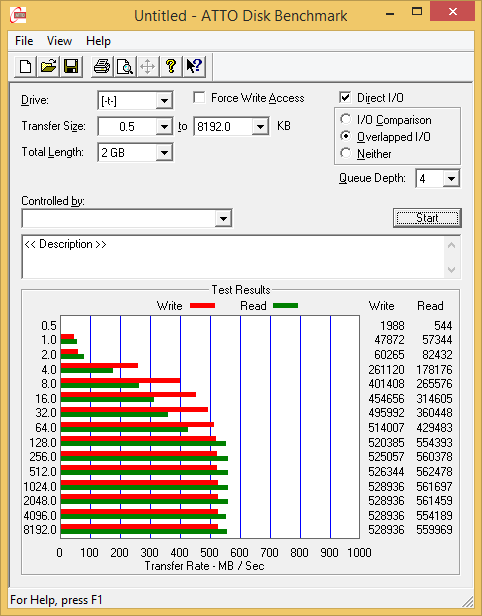 |
|||||||||
Both MK8115 drives have horrible performance on 512-byte transfers, far lower than anything else we've tested in recent memory. Reads are more than 100 times slower for 512B than 1kB transfers, and for writes the difference is a factor of 24. Most filesystems use 4kB or larger block sizes, but 512B accesses are still common enough that this is a fairly severe bug that needs to be dealt with in future firmware.
Beyond 512B transfers, the TLC drive's write speed scales up quicker than the MLC drive, but its read speeds struggle a bit. For 128kB and larger transfers, both drives are operating at full speed and performing similarly to each other and most SATA drives.
AS-SSD
AS-SSD is another quick and free benchmark tool. It uses incompressible data for all of its tests, making it an easy way to keep an eye on which drives are relying on transparent data compression. The short duration of the test makes it a decent indicator of peak drive performance.
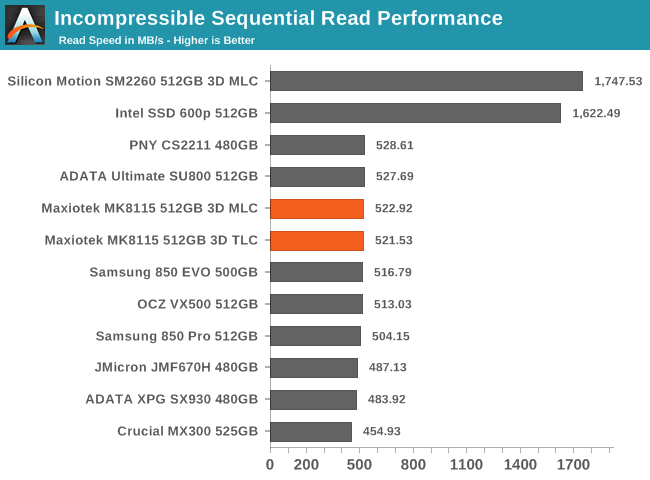
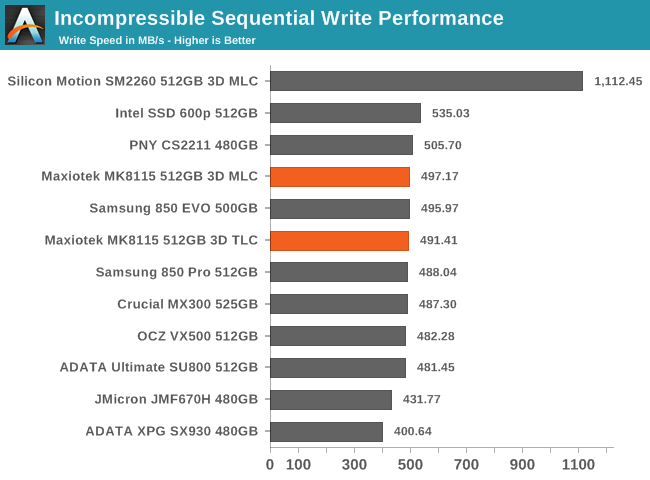
The MK8115 controller does make use of some compression, but its peak sequential read and writes speeds are not reliant upon the data being compressible. The MK8115 drives give AS-SSD performance that is typical for drives that are large enough to saturate the SATA link.
Idle Power Consumption
Since the ATSB tests based on real-world usage cut idle times short to 25ms, their power consumption scores paint an inaccurate picture of the relative suitability of drives for mobile use. During real-world client use, a solid state drive will spend far more time idle than actively processing commands. Our testbed doesn't support the deepest DevSlp power saving mode that SATA drives can implement, but we can measure the power usage in the intermediate slumber state where both the host and device ends of the SATA link enter a low-power state and the drive is free to engage its internal power savings measures.
We also report the drive's idle power consumption while the SATA link is active and not in any power saving state. Drives are required to be able to wake from the slumber state in under 10 milliseconds, but that still leaves plenty of room for them to add latency to a burst of I/O. Because of this, many desktops default to either not using SATA Aggressive Link Power Management (ALPM) at all or to only enable it partially without making use of the device-initiated power management (DIPM) capability. Additionally, SATA Hot-Swap is incompatible with the use of DIPM, so our SSD testbed usually has DIPM turned off during performance testing.
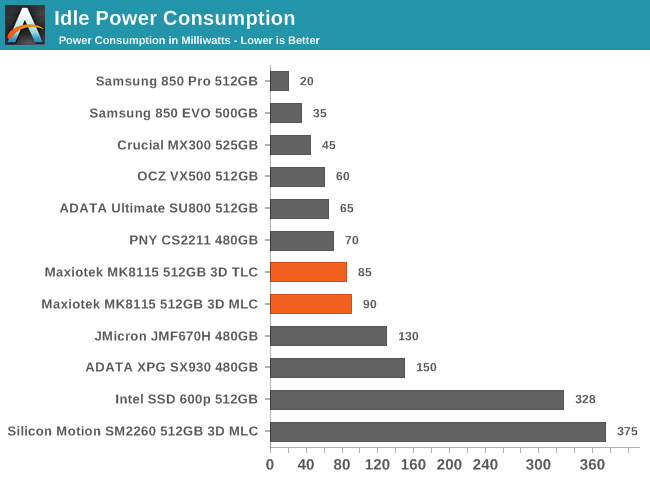
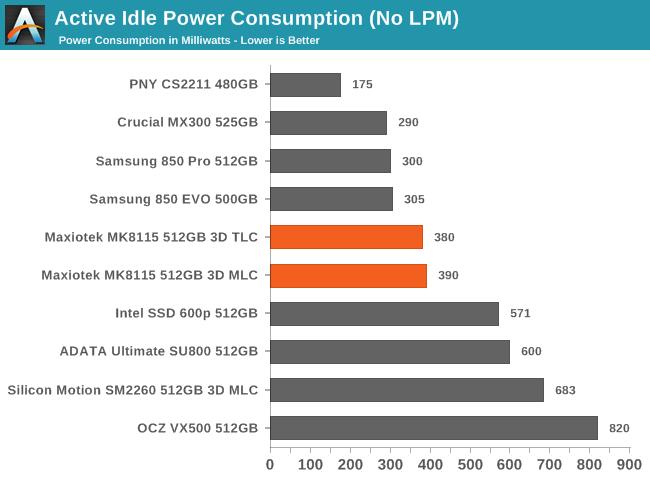
Idle power of the MK8115 is significantly improved over the JMF670H, but still lagging slightly behind the Phison-based PNY CS2211 and nowhere near the best SATA SSDs. Samsung and Marvell use more advanced lithography nodes for their controllers, and the smaller competitors on lagging fabrication processes can't beat them.
The active idle power consumption of the MK8115 drives is decent: it's clearly better than for the Silicon Motion drives or the OCZ VX500, but not quite as good as the Samsung and Marvell drives, nor the unusually efficient PNY CS2211.










60 Comments
View All Comments
CheapSushi - Wednesday, May 10, 2017 - link
So you sold someone something without researching the hardware in it yourself? Kinda shady but likely he still enjoyed it.rocky12345 - Wednesday, May 10, 2017 - link
Shady? It was a pre built with 3 year warranty the finer detailed spec's were not revealed as in brands like SSD or system memory. He also wanted a gaming system but did not want to pay a lot of money. I would normally build the system myself as a custom so you know what every part is inside and you get to choose the build quality but since he wanted a gaming system on the cheap he got a pre built system. He is happy with it and it actually is a nice system for the money and he got a 3 year warranty from the OEM. So nothing shady going on here...lolwatzupken - Tuesday, May 9, 2017 - link
I am not sure if the price of such DRAM less SSDs is worth buying over a normal budget SSD. In every instance, it is performing very poorly against a budget SSD with DRAM.Lolimaster - Sunday, May 14, 2017 - link
If you're not an OEM than will sells tons of system to uninformed customers, get a good TLC or MLC if possible.jabber - Tuesday, May 9, 2017 - link
Bring back the good old BX100!nervegrind3r - Tuesday, May 9, 2017 - link
inZGamer - Saturday, May 13, 2017 - link
As much as people complain about the low performance....when benchmarking the drive, why compare it against high end consumer SSD's? Compare it against HHD's and SSHDs's where it would actually make sense. This style of drive is not intended to compete against an EVO 850, maybe an MX300 but that would even be pushing it. It will be interesting to see where this is kind of budget SSD ends up on the $/GB scale when it actual reaches production.Lolimaster - Sunday, May 14, 2017 - link
People are actually getting scammed with the prebuild OEM systems with SSD because THAT's when they will include shi*tty dram-less SSD's (in bulk $5-10 off of each system to sell them at the same price is a lot for OEM's).Similar to TLC SSD's, dram-less SSD's consistency goes to sh*t when you empty the SLC cache, if you don't implement it, even worse, you basically get writes slower than a 5400rpm HDD with the system pegging.
I would only touch 850 EVO's, Crucial MX300 for TLC, Kingston HyperX Savage or 850 pro for MLC.
genzai - Tuesday, May 16, 2017 - link
Seems like one good use for Optane would be to replace the DRAM (over a DDR interface) on drives like these.